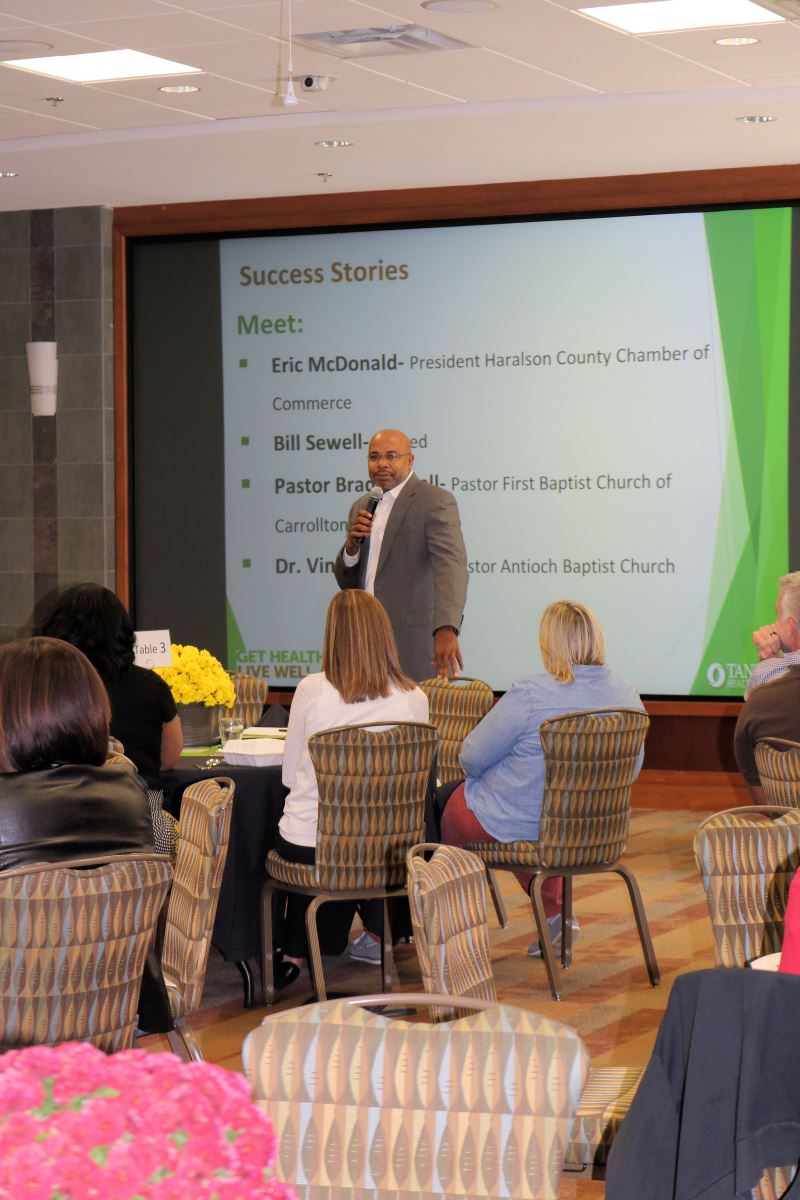The year 2014 took a tragic turn for Antioch Missionary Baptist Church Pastor Vincent Dortch when his wife suddenly passed away after having a stroke. 
Unexpectedly having to cope with the death of a loved one often leads to thoughts of one’s own mortality. And for Dortch, health and wellness became a priority.
“It put me in a position where I was very conscious about my health,” he said.
Dortch not only became more conscious of his health, but also the health of his congregation. So when Tanner Health System’s Get Healthy, Live Well introduced the evidence-based Diabetes Prevention Program (DPP) to his church, a partnership soon developed that continues to positively impact the health of his congregants.
“I want to thank Tanner for introducing the program to Antioch Missionary Baptist Church,” said Dortch. “It truly has been a blessing to my members. We’ve seen a lot of changes with the members. One deacon that was taking over 10 types of medication is now down to three, so we praise God for that.”
Other steps church members took to adopt healthier lifestyles included planting a garden and banishing fried chicken from gatherings where food is served.
That was one of several stories that was told during a meeting of the Get Healthy, Live Well Coalition, a multi-sector community coalition working to eliminate tobacco use, expand access to healthy food, increase physical activity and reduce chronic disease risks in Carroll, Haralson and Heard counties. The coalition consists of businesses, educational institutions, community groups and faith-based organizations.
Denise Taylor, senior vice president and chief community health and brand officer for Tanner, thanked every partner who has joined Get Healthy, Live Well’s efforts to provide community members the resources they need to lead healthier lifestyles.
“They are all leaders in their respective communities and have put so many years into doing great things for the community,” said Taylor. “We are so appreciative that they would give their time and talents to be part of the Get Healthy, Live Well Coalition.”
Since 2011 when Tanner conducted its first Community Health Needs Assessment (CHNA), the health system has been working to build a culture of health — a community where good health flourishes across demographic, geographic and social sectors. The following year, Tanner received initial funding from the Community Foundation of West Georgia to support Get Healthy, Live Well. In April 2012, the Get Healthy, Live Well Coalition was born and the community’s health goals were established later that year.
With the help of two grants from the Centers for Disease Control and Prevention (CDC), Get Healthy, Live Well has been able to continue its work to transform west Georgia into a healthier community. Over the years, the coalition has worked to address tobacco-free living; healthy food access; physical activity; and community prevention, wellness and health education. So far, the coalition has provided Freshstart tobacco cessation programs to 700 individuals. It has also established a local chapter for Safe Routes to School, which has led to a 700 percent increase in walkers and bikers.
Other major accomplishments include establishing an inpatient Diabetes Health Education Program to help people in the hospital learn to control diabetes after they’re discharged, reducing the risk for rehospitalization, and introducing chronic disease self-management programs like Living Well With Diabetes.
“Eating healthy and exercise can have a huge impact on combating disease,” said Taylor. “We’re really trying to help people prevent disease. But we also want to help people who have a lifelong condition learn how to manage that disease as well, which can have a meaningful and lasting impact in their quality of life.”
Based on the 2016 County Health Rankings, it appears efforts to improve community health are working. In Carroll County, the percentage of adults who smoke decreased from 23 percent in 2013 to 18 percent in 2016. In nearby Haralson County, the percentage of adults who are obese dropped from 31 percent in 2013 to 29 percent in 2016.
In November, the coalition established new goals based on the key issues identified in the 2016 CHNA. Those issues include access to care; behavioral health (especially substance abuse treatment); health education and literacy; and chronic disease prevention and management. The chronic conditions targeted will be cancer, diabetes, heart disease and obesity.
To address these issues, the coalition is comprised of several targeted committees: Healthy, Safe and Active Communities; Faith-Based; Nutrition/Healthy Food Access; Access to Care, Behavioral Health, Health Education/Literacy, Chronic Disease Prevention and Management; and Social Determinants of Health.
The new committees introduced this year include Behavioral Health, Health Education/Literacy, and Social Determinants of Health.
“This is the first time we’ve had a behavioral health committee, so they’re working on community-based behavioral health as well as substance abuse,” said Taylor. “With the Social Determinants of Health Think Tank, we really want to look at all the factors that contribute to poor health and what we need to address in the community.”
The Health Education/Literacy committee will explore culturally and linguistically appropriate health information.
“We knew early on that the only way to make a real impact on health was to bring local community leaders and volunteers to the table,” said Taylor. “Partnership and volunteer engagement has been the most important thing that we’ve been able to accomplish. Making a community-wide change requires community involvement.”
Get Healthy, Live Well is still looking for others in the community to find their passion in helping improve the region’s health. More information about the coalition’s work and ways to participate and contribute is available at GetHealthyLiveWell.org.